First Manassas/Bull Run Campaign, July 21, 1861: Uniforms
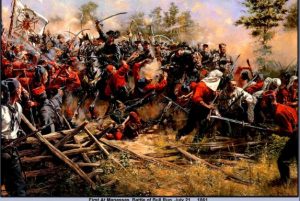 Civil War uniforms tend to be a specialty subject. This may be because the photographs are in black and white or sepia-toned. Hence the student must dig through letters and memoirs to get a clear idea of what each uniform looked like. It’s tedious and not that fun. Nevertheless, the topic can tell us a lot. The story of uniforms was especially important at the Battle of First Manassas/Bull Run.[1]
Civil War uniforms tend to be a specialty subject. This may be because the photographs are in black and white or sepia-toned. Hence the student must dig through letters and memoirs to get a clear idea of what each uniform looked like. It’s tedious and not that fun. Nevertheless, the topic can tell us a lot. The story of uniforms was especially important at the Battle of First Manassas/Bull Run.[1]
Both Confederate and Union units wore the gaudiest uniform on the battlefield: the Zouave (zooav’) outfit. It was modeled after the Algerian light infantrymen. These soldiers fought in the French Colonial Armies during the Crimean War (1853-56). Why would a company or regimental commander in the United States offer these to their men? It is the age-old answer. These brightly colored uniforms attracted more recruits and media attention. The outfit was mesmerizing; the cut was distinctive. In short, these were the coolest and baddest uniforms out there.
The Confederate “Tiger Rifles,” Company B, donned a Zouave uniform. This company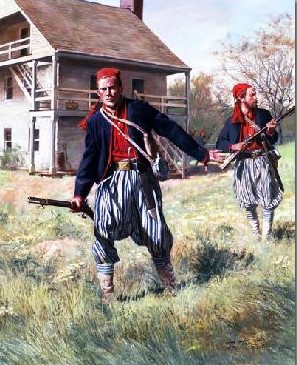 belonged to Major Chatham Roberdeau Wheat’s Special Battalion, Louisiana Volunteers. The unit didn’t just look bad in their attire; it was comprised of actual hardened criminals. Many of the men had been recruited from the alleys and jails of New Orleans. A. Keene Richards, a wealthy local businessman bought this unit their outfits. Their uniform included red shirts and blue or tan jackets with baggy, blue and white striped trousers and white gaiters. On their heads, the men wore scarlet skullcaps with long tassels. Some Louisianans painted slogans on their hatbands: “Lincoln’s Life or a Tiger’s Death,” “Tiger in Search of Abe,” and, “Tiger in Search of a Black Republican.” These guys meant business.
belonged to Major Chatham Roberdeau Wheat’s Special Battalion, Louisiana Volunteers. The unit didn’t just look bad in their attire; it was comprised of actual hardened criminals. Many of the men had been recruited from the alleys and jails of New Orleans. A. Keene Richards, a wealthy local businessman bought this unit their outfits. Their uniform included red shirts and blue or tan jackets with baggy, blue and white striped trousers and white gaiters. On their heads, the men wore scarlet skullcaps with long tassels. Some Louisianans painted slogans on their hatbands: “Lincoln’s Life or a Tiger’s Death,” “Tiger in Search of Abe,” and, “Tiger in Search of a Black Republican.” These guys meant business.
Another Confederate Zouave unit hailed from Maryland. This was the “Maryland Guard,” part of the 1st Maryland Infantry Battalion. The Maryland Guard considered themselves a Zouave unit because on dress parade they wore a dark blue version of the uniform. In battle, the Guard substituted their tight, short coat for a more generous blue jacket and black, fitted trousers. Their outfit also included a blue kepi trimmed with yellow and a blue undershirt.
The Union army had two Zouave units heavily engaged at First Manassas/Bull Run. The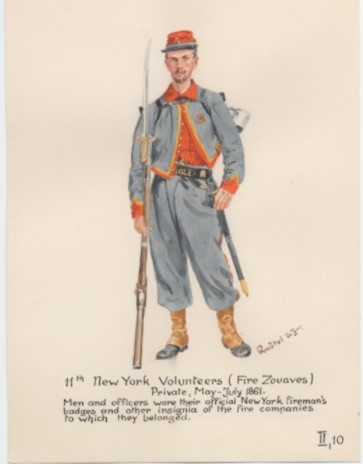 most famous was the 11th New York. It earned the nicknamed the “Fire Zouaves” because the majority of enlisted men had been firemen in New York City. The soldiers shaved their heads like their Algerian counterparts. One even had his hair shaved in the form of an American Bald Eagle. Due to the heat on July 21, the men discarded their jackets. The 11th New Yorkers wore either red or light blue shirts, baggy, blue-gray pants, and leather gaiters. The other Zouave unit included Company K, 69th New York, Captain Thomas Meagher’s Zouaves. Like the 11th New York, many of Meagher’s men removed their jackets and fought with their shirt sleeves rolled up to their elbows.
most famous was the 11th New York. It earned the nicknamed the “Fire Zouaves” because the majority of enlisted men had been firemen in New York City. The soldiers shaved their heads like their Algerian counterparts. One even had his hair shaved in the form of an American Bald Eagle. Due to the heat on July 21, the men discarded their jackets. The 11th New Yorkers wore either red or light blue shirts, baggy, blue-gray pants, and leather gaiters. The other Zouave unit included Company K, 69th New York, Captain Thomas Meagher’s Zouaves. Like the 11th New York, many of Meagher’s men removed their jackets and fought with their shirt sleeves rolled up to their elbows.
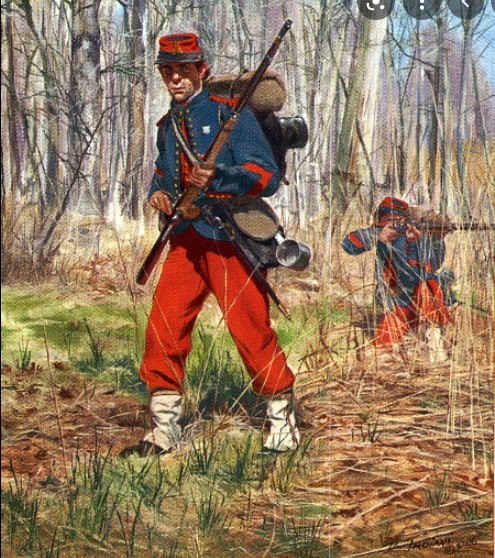 “Red-Legged Devils” of the 14th Brooklyn Chasseurs dressed similarly to the Zouave style. Their uniform included red caps, red baggy trousers, short, blue jackets, and white gaiters. Chasseur and Zouave uniforms differed primarily in the cut of their coats and trousers and the color of their pants. Traditionally, the French army utilized Chasseurs as light infantry, equipped for reconnaissance and screening purposes. The Chasseur units during the Civil War functioned as any other infantry regiment.
“Red-Legged Devils” of the 14th Brooklyn Chasseurs dressed similarly to the Zouave style. Their uniform included red caps, red baggy trousers, short, blue jackets, and white gaiters. Chasseur and Zouave uniforms differed primarily in the cut of their coats and trousers and the color of their pants. Traditionally, the French army utilized Chasseurs as light infantry, equipped for reconnaissance and screening purposes. The Chasseur units during the Civil War functioned as any other infantry regiment.
Now, among the majority of Union regiments, the Soldiers donned the volunteer regulation outfit. This encompassed a dark blue forage cap (kepi), a dark-blue wool coat (the soldiers called this a blouse), with a flannel shirt underneath (red or gray or white). The men had dark or sky-blue trousers, long-underwear, “drawers,” wool socks, and short ankle boots. To protect the back of the neck from the sun, havelocks were issued. These looked like a flap of cloth that was draped around the cap. The Soldiers, however, found that the havelocks scratched the back of their necks. Many either threw them away or used them to bandage wounds. The 79th New York “Highlanders” also wore this volunteer regulation outfit.
There was one other color seen among the Union army. Several regiments went into battle wearing their gray state militia uniforms. These included 2d Maine, 3d Maine, 5th Maine, 1st Massachusetts, 11th Massachusetts, 2d New Hampshire, 8th New York, 2d Wisconsin, and three companies in the 1st Minnesota. The 1st and 2d Rhode Island had a combination uniform: gray pants and blue coats.
The Confederate army fielded a hodgepodge of uniforms. Many of their units donned all-gray outfits; many other poorer companies wore civilian clothes. Brigadier Generals Thomas Jackson and Barnard Bee dressed in their U.S. Regular Army dark blue uniforms. Even Company A of the 2d Virginia donned a dark blue regular army uniform. Young men, who had left their military schools, came dressed in “cadet gray” (blue-gray color). Other Soldiers fought wearing a combination outfit: blue jacket, a white, blue, or red undershirt, steel gray trousers and a kepi.
The lack of consistency seen on both sides had serious consequences at the tactical level. Union Zouave units and 14th Brooklyn were easily distinguished. Private Lewis Francis of the Chasseurs, wearing his bright red pants, was targeted. Two Confederates attacked and bayoneted Lewis fourteen times. The incident ended when one of his adversaries ran off; the other was shot dead. Somehow, the Brooklynite survived the ordeal. Those wearing the gray uniform, particularly in the Union regiments, found themselves shot at by everyone. The thick black smoke made it extremely difficult for the commanders to identify the enemy. Rather than identify the gray-clad regiments, officers ordered their men to fire. Friendly fire thus killed or wounded many Soldiers. Confederate Brigadier General Bee, in his dark blue U.S. Army uniform, may have even been mortally wounded by his own men.
After First Manassas/Bull Run, uniforms had less tactical effect on the battle. A majority of Union regiments adopted the regulation volunteer uniform. The Confederates fielded units in gray uniforms, civilian clothes, or a makeshift outfit. This didn’t mean friendly fire ended. It just meant that other factors entered into the unfortunate incidences taking place.[2]
[1] This blog is taken from JoAnna McDonald, “We Shall Meet Again”: The First Battle of Manassas (Bull Run) (White Mane: Shippensburg, PA, 1999), 2–5. If anyone would like specific notations, please let me know.
[2] Illustrations herein are by Don Troiani. The drawing of the 11th New York Zouave is found at https://www.pinterest.com/pin/822329213186660369/
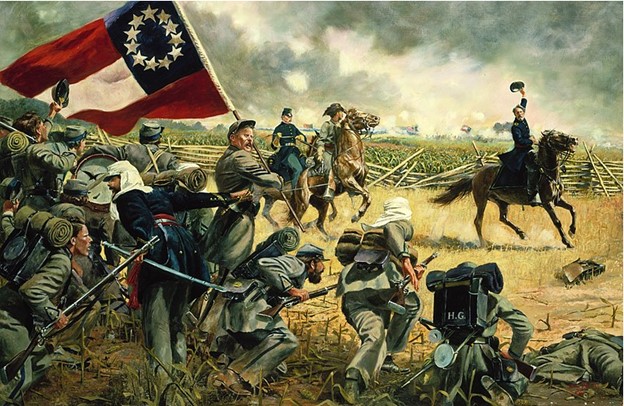
2nd Vermont also wore “doeskin” gray
Thank you Charles, I put a note in my book. Seems the New England regiments wore the most gray/doeskin at Bull Run.
Ma’am,
I most thoroughly enjoyed your book and took particular interest in the roles played by the Union Marines and the Massachusetts regiments. Well done!
Timely publication of this information, because in the process of reviewing Roman’s “Military Operations of General Beauregard,” I encountered a paragraph (page 75) that expressed Beauregard’s concern with “the abundance of non-gray uniforms, worn by the Southern soldiers, in the field before Manassas.” In an attempt to address this deficiency in the short term, General Beauregard proposed that “a sash of uniform color be issued to every soldier of the Confederacy; this sash to be worn from the shoulder to the waist; and the women of Richmond were nominated to create the thousands of sashes required.” Delay and dithering resulted in “So imperfect a contrivance – a sort of rosette, to be pinned on the arm or breast – that on the field of Manassas, in the critical moment, the troops themselves were confused as to identity…”
Prior to conducting in-depth study of the Civil War, I had been hoodwinked by the summarization of the contest as “the Blue versus the Gray.” Then the inconvenient Zouaves appeared… and after them, the non-gray, but accepted (temporary) Uniform of the Confederacy: butternut.
Thanks again for introducing this topic.
Thanks Mike, need to re-read Roman’s book, good quote. Uniforms are an interesting subject. I think the Confederates wore whatever they could get their hands on but yes, butternut was a prevalent color among the Southern boys.
“These brightly colored uniforms attracted more recruits and media attention.”
There was an important reason they attracted more recruits (at least in those days): nothing like a spiffy uniform to catch the attention of the ladies!
Nice article JoAnna! In addition to the uniforms worn, another change that came about after 1st Manassas was to the flag the Confederate forces carried on the battlefield. Due to the inability of troops on both sides to easily distinguish the Stars and Stripes from the Stars and Bars during the battle, the wheels were started in motion that led to the design of the Confederate battle flag, which would become the flag of the Confederate soldier from late 1861 until the end of the war. It was never meant to later become representative of the KKK, white supremist groups or modern-day rednecks, who don’t even know if they have any Confederate ancestry. One more thing while it’s on my mind – The Confederate battle flag is totally different from the 1st National Confederate flag, also known as the Stars and Bars. Many people are ignorant of this fact, and often mistakenly refer to the battle flag as the Stars and Bars. Also, the battle flag was never an official flag of the CSA, so it was never flown over any Confederate government buildings.
have to mention there were some red shirted 1st MinnesOta boys at Bull Run 1. At the hot as dickens 150th anniv reenactment they were present, too.